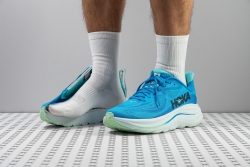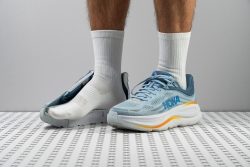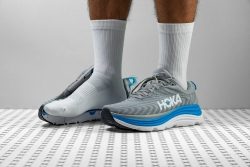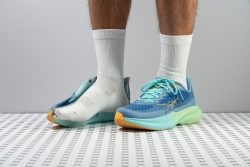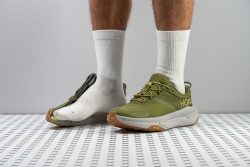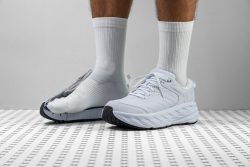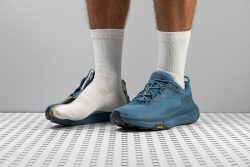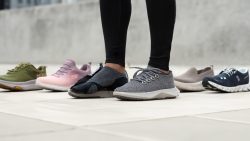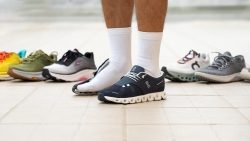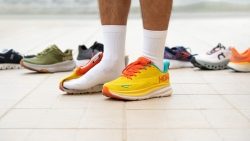7 Best HOKA Walking Shoes in 2025
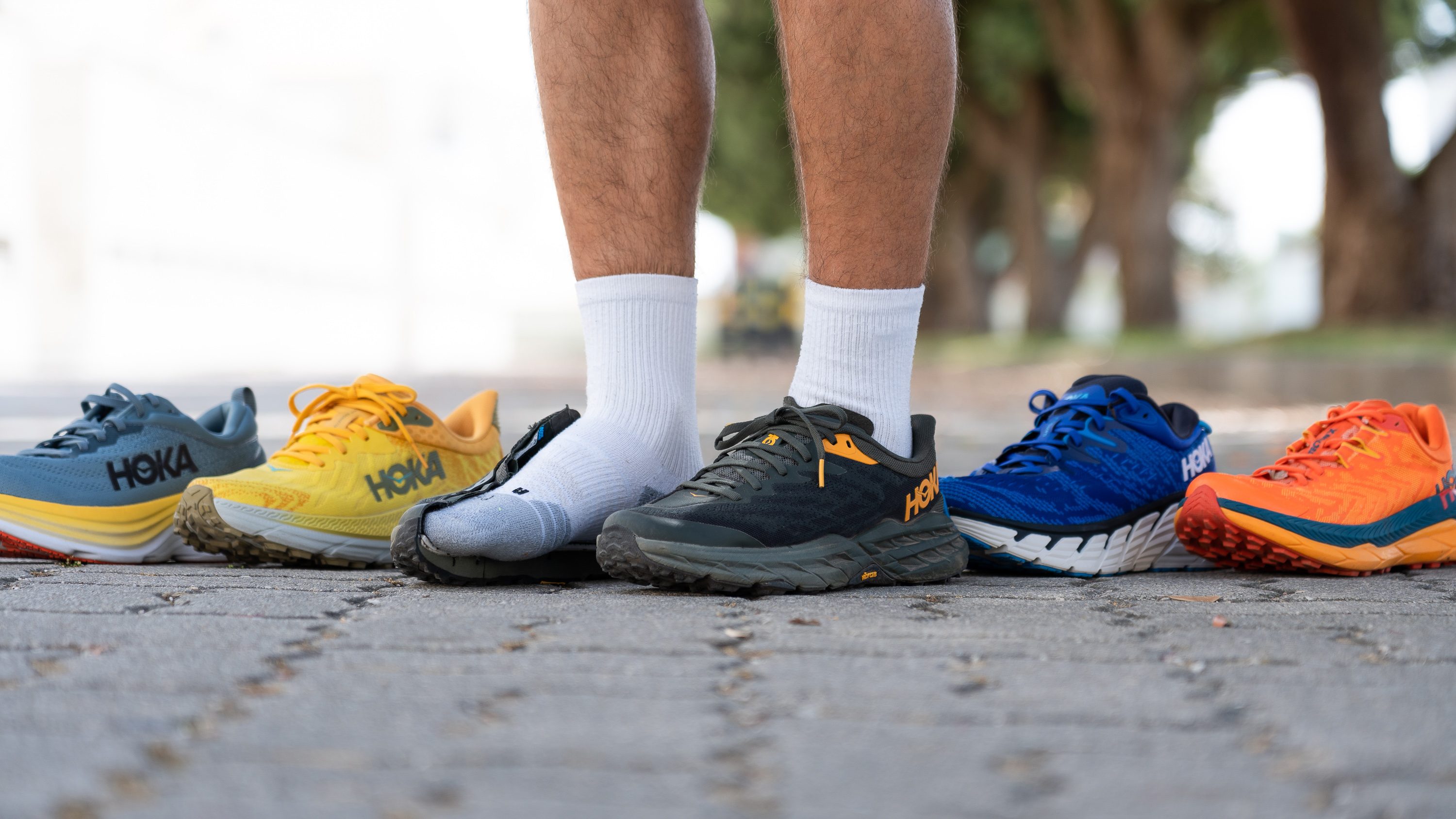
We buy shoes ourselves. We earn commissions when you buy through us, at no extra cost. Why trust us
A good pair of walking shoes can take you far, literally and figuratively. Besides being comfortable and stable, walking shoes can also be hip and stylish, so you can show them off when strolling around the town.
One brand that has been making waves in the walking realm is Hoka. Boasting its comfortable, supportive, and durable footwear collection, this brand has been dubbed one of the podiatrists' favourites for countless fantastic reasons. And we sure did experience what Hoka has to offer when we put them on our feet and tested them away!
If you're interested in getting a pair or two, we've listed our top picks under various categories here to make your Hoka walking shoe hunting quick and easy.
How we test HOKA walking shoes
Here is our approach to give you an honest and fair review:
- We buy these shoes using our money to avoid any biased feedback or pressure from the brands.
- We subject them to dozens of lab tests, which result in more than 20 data points for each walking shoe! We make this data comparable across the walking shoe category so it's easy to find the Hoka walking shoe with the best shock absorption, or the one with the stiffest heel counter, or the one with the lowest heel drop. Plus, we split the shoes in half to have a better look at what's inside.
- We test the shoes by wearing them daily: walking indoors and outdoors, going to work, travelling.
Best HOKA walking shoes overall
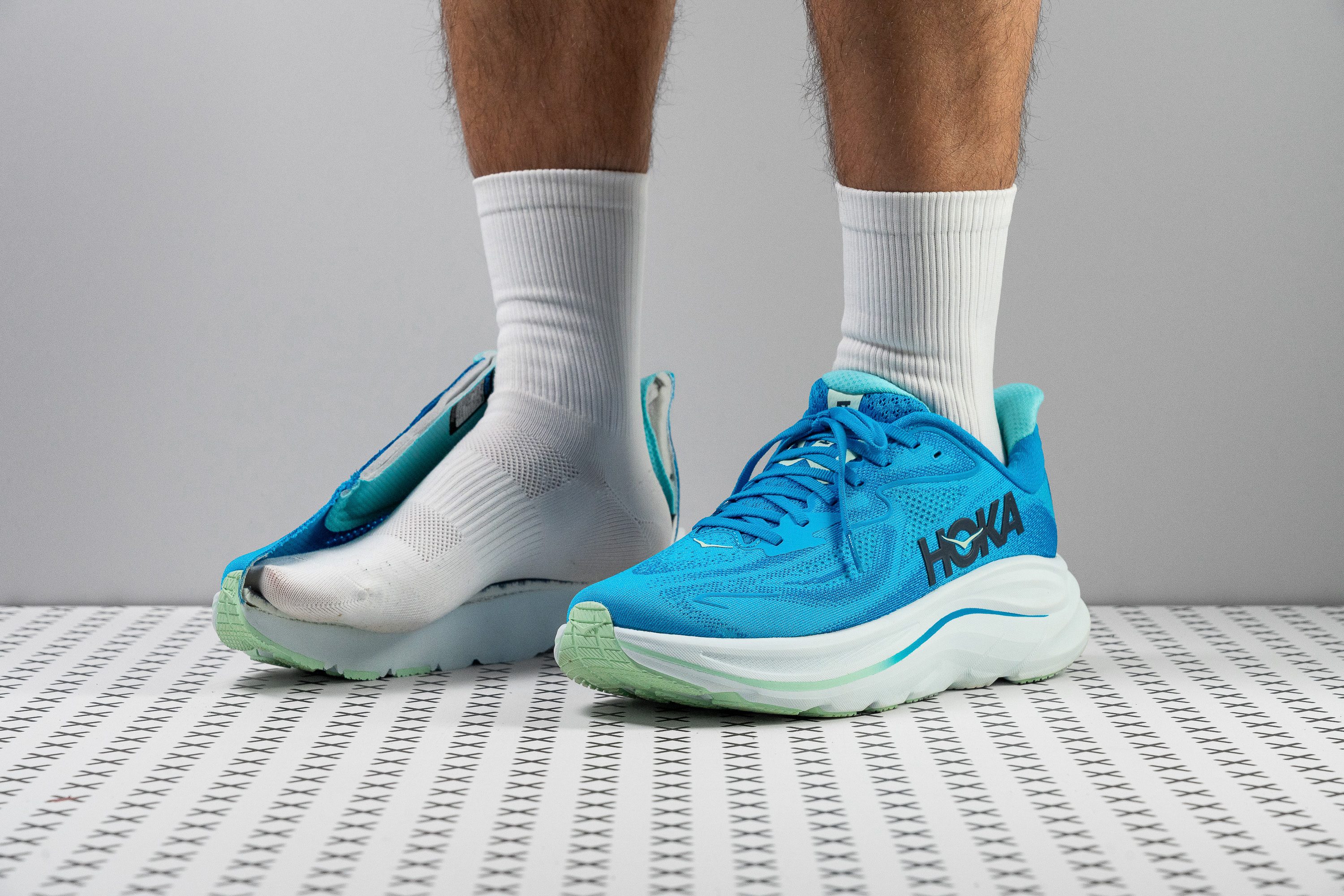




















































What makes it the best?
We found the Clifton 10 perfect for long hours on foot, with its generous offering of comfort and stability without losing its adaptability. In the lab, we were impressed by how it balances flexibility and support even with its skyscraper stack. Clifton 10 is in a league of its own, making it our top Hoka walking shoe.
Our joints enjoyed unmatched levels of comfort in its super high 44.4/32.0 mm stack height. Besides the bottomless cushioning, the foam itself reduces impact better than average. In our shock absorption test, it reached stellar scores of 147 SA (heel) and 122 SA (forefoot), reducing strain better than average.
Despite its ultra-thick setup, we had no instances of losing our balance. Clifton 10 has tall midsole sidewalls and a broad base that keep us centred, confirmed with a calliper measurement of 116.9/97.8 mm.
Thankfully, moving forward feels easy since the midsole bends naturally with our feet. In our bend test, it earned a near-average 14.7N flexibility score, proving its comfort for all-day wear.
Clifton 10 has some airflow, but it will lead to overheating on very hot and humid days. People in tropical climates may want to consider a more breathable shoe.
Pros
- Superb joint protection
- Wider toebox improves toe splay
- Comfortable upper
- Stable ride despite its high stack height
- Works well for heel strikers
- Ideal for long runs
- Versatile for daily walking or jogging
- Achilles-friendly heel collar design
- Traction improvements
Cons
- Needs a better foam ASAP
- Notable weight gain from v9
- Feels more Bondi than Clifton
- Non-gusseted tongue
HOKA walking shoes with the best shock absorption
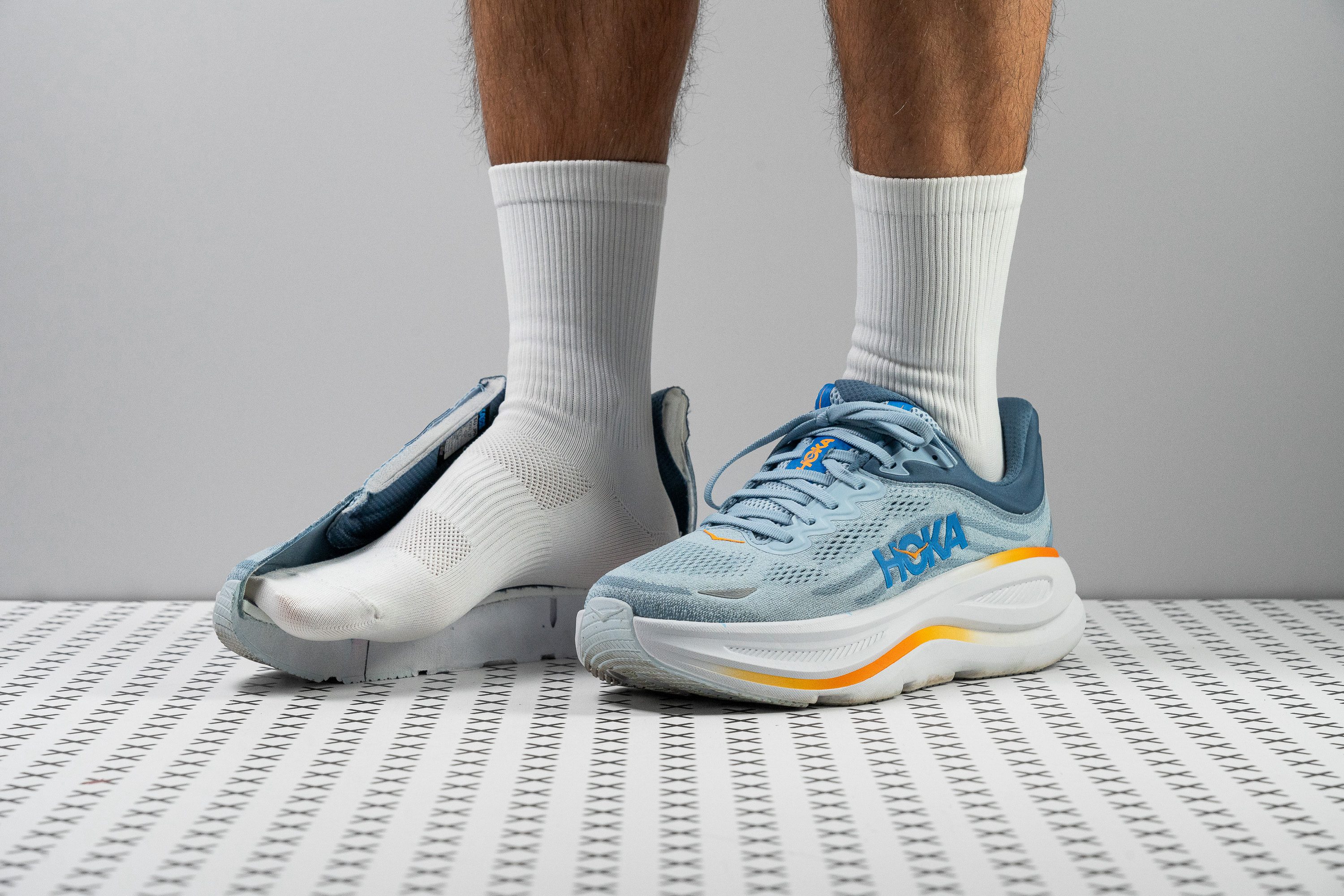



















































What makes it the best?
Bondi 9 provides unmatched impact protection in our walks with its humongous cushion. Our lab tests validate that it's built with plush padding all around, giving an embrace that feels like home. Keeping our feet happy all day, it’s undoubtedly the Hoka walking shoe with the best shock absorption.
With calliper measurements of 41.3/32.2 mm, Bondi 9 features a mega stack and is 6.9/6.3 mm higher in the heel and forefoot, respectively. This thicker slab of foam keeps our legs fresh from mile 1 and beyond. Taking its comfort to the next level is its high shock absorption scores of 146 SA (heel) and 133 SA (forefoot), with above-average scores proving it reduces leg strain better.
This shoe is not only comfy on the bottom, but also on top! Our calliper measured the plush tongue to be 9.0 mm, 3.2 mm thicker than average, keeping us worry-free from lace bite and unwanted pressure.
Despite its high stack, our steps feel steady and smooth. The shoe has a wide landing platform and elevated midsole sidewalls that enhance stability. Our calliper agrees with a solid 123.1/104.2 mm base vs. the 114.3/90.7 mm average.
While the base is wide, the toebox is surprisingly tight, and it shows in the lab. Those looking for extra room for toe-splaying should find more accommodating shoes.
Pros
- Endless cushioning
- New supercritical EVA midsole
- Amazing step-in comfort
- Doubles as a walking shoe
- Stable for its height
- Built to last
- Excels at slow-and-steady paces
- Well-designed heel collar
- Lighter than v8
Cons
- Not for wide feet
- Still feels heavy and clunky underfoot
- Drop measurement differs from stated
- Non-gusseted tongue
HOKA walking shoes with the best arch support
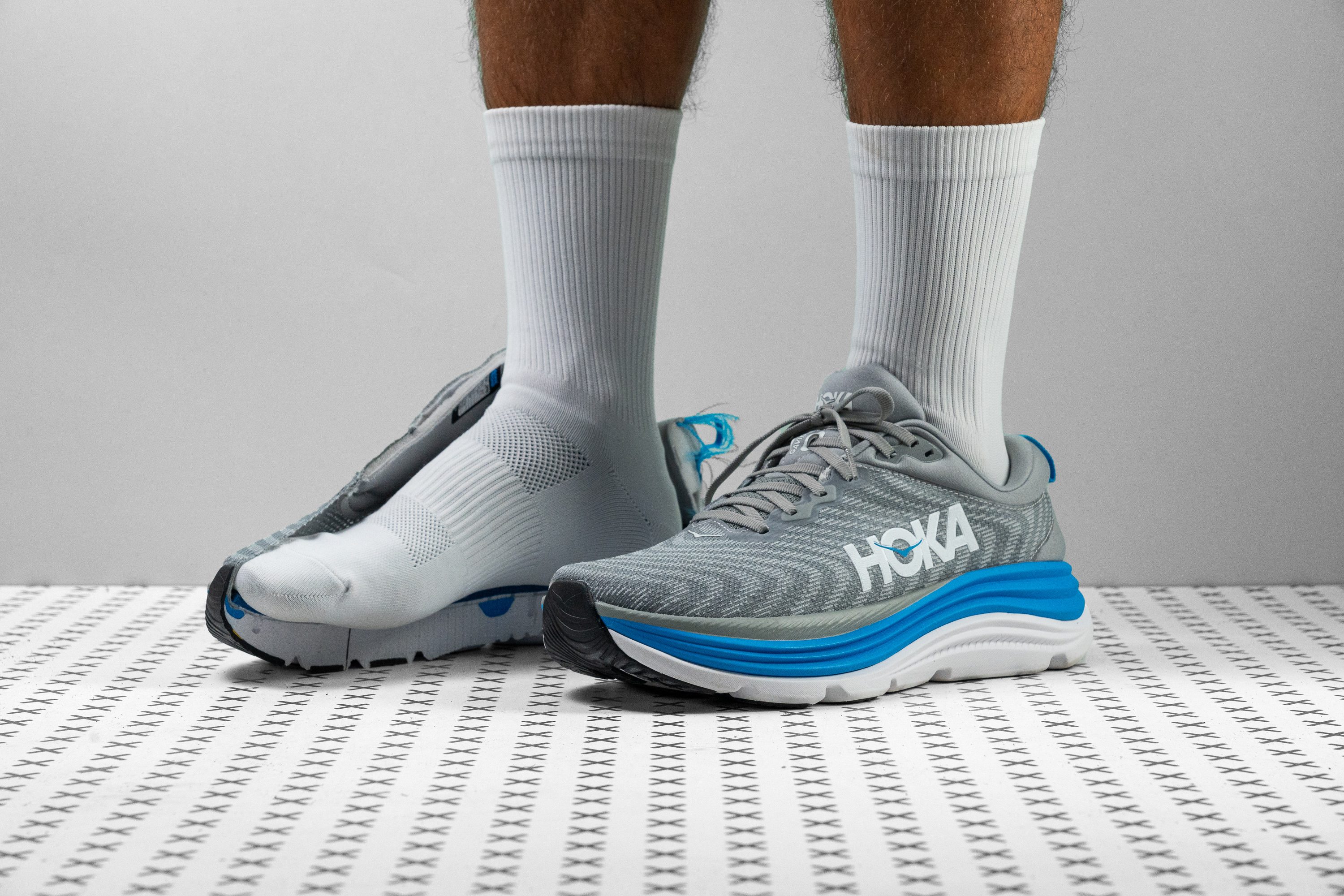


















































What makes it the best?
Among lab-tested Hoka shoes, our walks with Gaviota 5 felt most delightful as it offered unwavering arch support—no pain and localised tensions. Suitable for those with instability, Gaviota 5 keeps the ride forgiving by infusing gentler features within the shoe’s firm construction.
Deviating from the typical stability shoe, Gaviota 5 features a luxurious stack for leg-saving comfort. The composition includes two foams, each with a specific purpose: the main cushion is a plush 12.9 HA to carry our arches comfortably while the firmer 22.0 HA layer is situated in high-impact areas for better balance and protection. This setup empowered us to prolong our walks as our legs felt fresh.
Two elements further improved our foot alignment: the vast landing base and the H-Frame. Our calliper reveals a spacious 125.1/106.6 mm for finding our footing. Meanwhile, the H-Frame adds some resistance to the midsole so that excessive motions are mitigated.
Making Gaviota 5 a great place to be in all day is its accommodating toebox and unrestricted upper. As its 5/5 breathability rating shows, we had an overflowing amount of ventilation that effectively prevented blisters and sweaty feet.
However, we warn those who heel-strike and have lower-leg problems to look for alternatives since the shoe’s minimal 2.2 mm drop may not support their needs.
Pros
- Remarkably stable
- Breathable and comfortable upper
- Lightweight for its size
- Good stability option for forefoot strikers
- Ideal for wide feet
- Excellent for long runs
- Excellent for long runs
Cons
- Low drop might pose issues for heel strikers
- Performs poorly in colder conditions
- Not for narrow feet
- Midsole feels flat
Best lightweight HOKA walking shoes
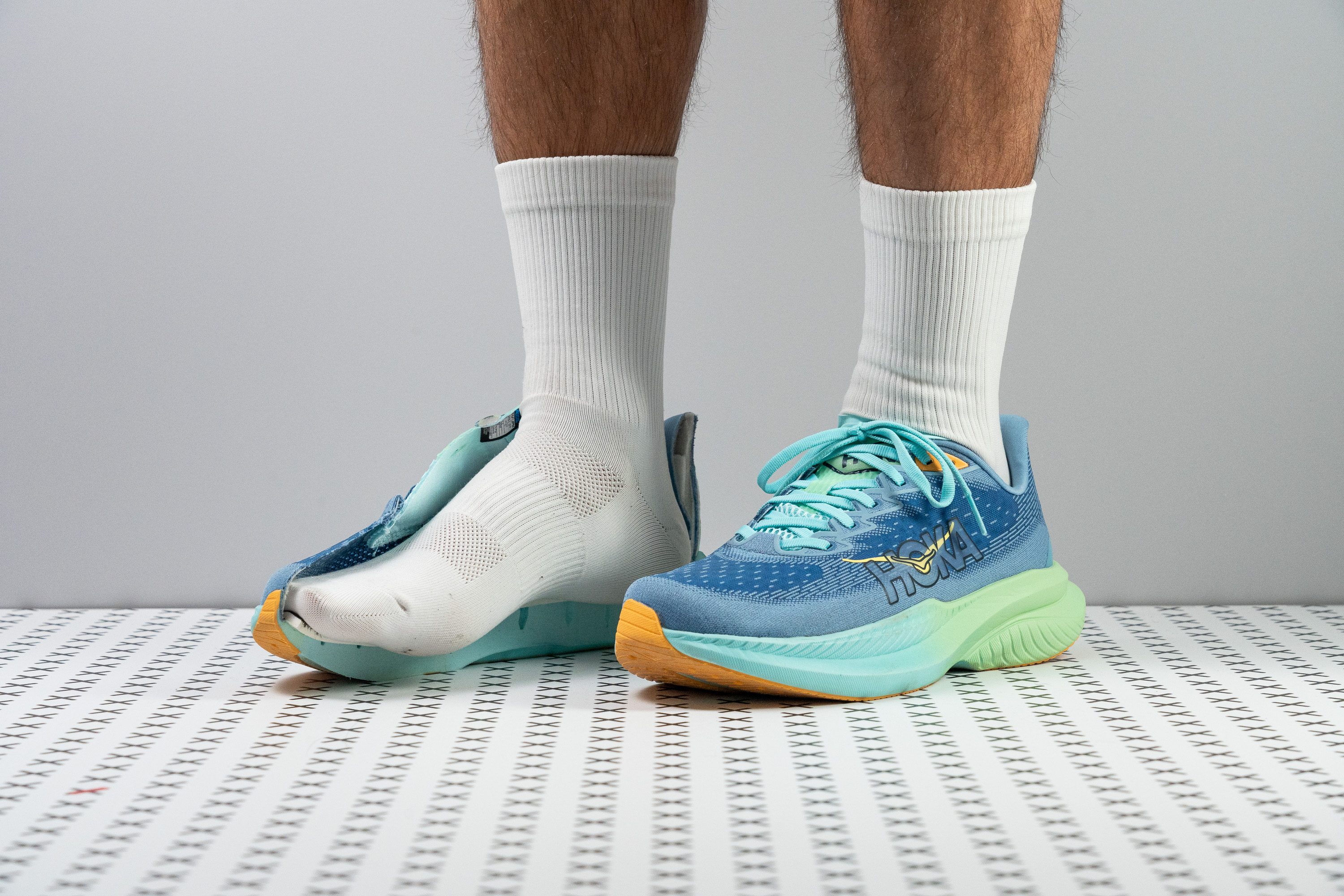























































What makes it the best?
The Hoka Mach 6 impressed us both in the lab and on the streets with its featherweight design and exceptional comfort. It feels highly agile on foot, easily handling various activities like walking, running, and even other workouts. Undoubtedly, it’s our best lightweight Hoka walking shoe.
Despite its substantial stack height of 36.0/26.4 mm vs. the 32.6/21.7 mm average walking shoe, it remains surprisingly light at 8.2 oz (232g), a significant 14.1% below average. This lightweight build ensures a pleasant experience, with our legs feeling fresh even during longer walks.
Testing its hardness with our durometer reveals a 20.4 HA measurement, making it 18.4% softer than the average walking shoe. Despite its plush nature, it provides a lively response with each step without sinking into the foam. Its rocker also aids with our forward momentum and silky-smooth transitions.
Further enhancing comfort is its free-spirited midsole, bending effortlessly with our feet. Our flex test confirms it’s 8.3% more adaptive than the average walking shoe, which further adds to its weightlessness because it barely resists our movements.
However, the shoe runs quite narrow vs. average. We recommend those with wide feet to go for a more accommodating shoe.
Pros
- Really lightweight
- Fantastic outsole
- Exciting ride
- Highly cushioned
- Great for heel strikers
- Handles faster paces
- Superb lockdown
- Excellent value at $140
Cons
- Drop varies from stated
- Tapered toebox
- Thin tongue
Best city-to-trail HOKA walking shoes
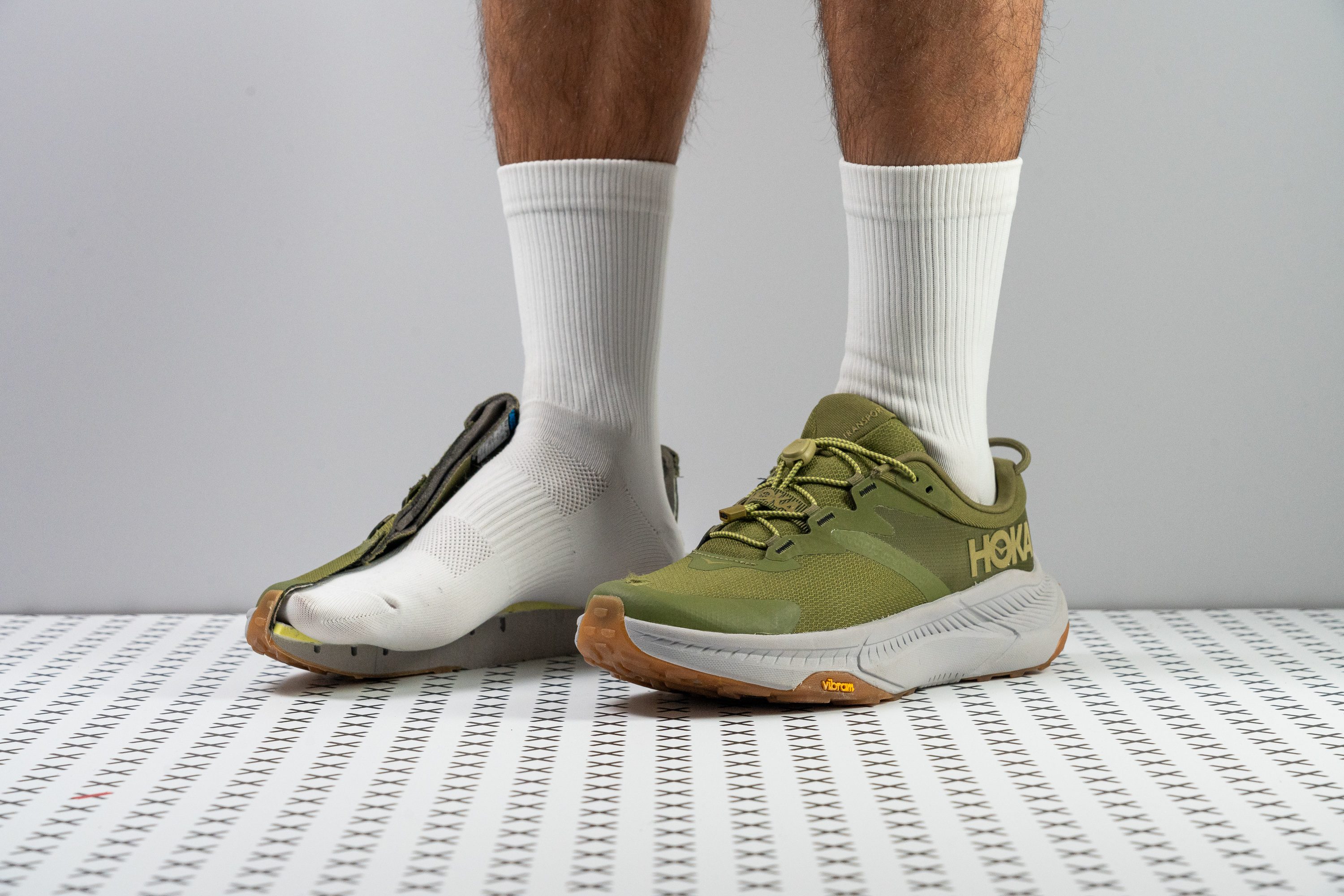





































What makes it the best?
The Hoka Transport, as seen in its name, is designed for daily commutes and long hours on foot. It offers just the right amount of comfort and support through its wide and cushioned midsole, which we verified in the lab. Made of world-class Vibram rubber, it can handle any surface and take the beating of daily wear, making it our best city-to-trail Hoka walking shoe.
The Vibram outsole takes centre stage, offering reliable grip even on wet asphalt or loosely-packed trails. It barely had any wear after our tests, and our high 81.9 HC durometer measurement proves its toughness. Its 3.7 mm thickness adds longevity, since the average is only 3.0 mm.
The midsole serves as an effective impact dampener, with a thick 34.1/26.1 mm foam between our feet and the ground. In addition, the foam itself took care of our joints with its high 116 SA rating in our shock absorption test.
To keep each step well-balanced, the base runs wide at 112.8/92.5 mm. It also features a rocker geometry that makes forward movement feel natural and smooth.
However, Transport feels the comfiest in cool weather. The upper has limited airflow, so we can’t recommend it during warmer seasons.
Pros
- Well-cushioned for all-day wear
- Spacious toe box
- Superior traction
- Reliable outsole durability
- Easy to slip in and out
- True-to-size fit
- Easy to clean
- Sustainable
- Sustainable
Cons
- Not great for warm weather
- Squeaky during break-in
Best slip-resistant HOKA walking shoes
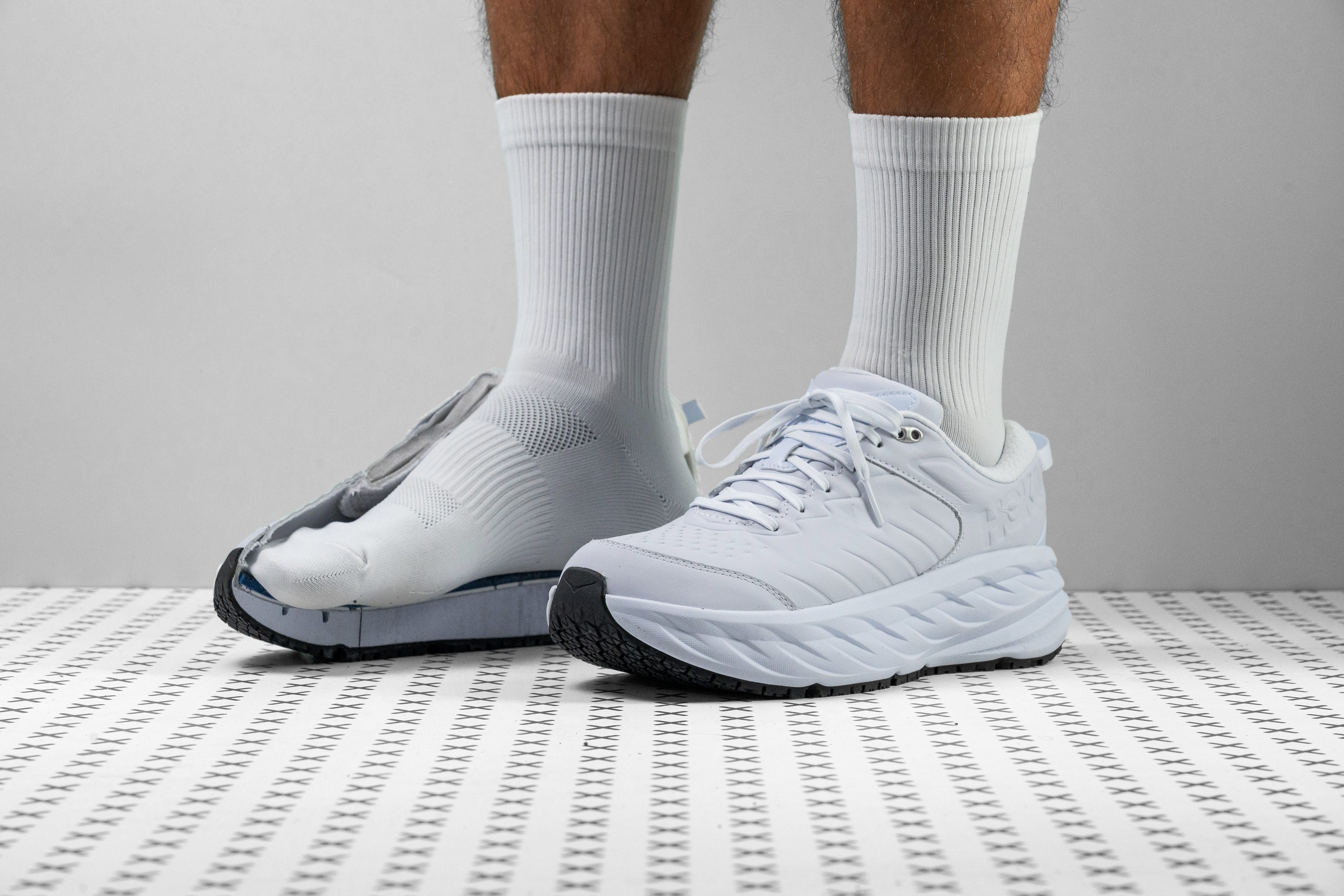










































What makes it the best?
Hoka Bondi SR is unbeatable as the greatest slip-resistant Hoka walking shoe for work because we feel invincible whenever we are in the pair. Even though we are slaving at our 8 to 12-hour jobs, Bondi is so easy on the feet that we never feel tired down below. The safety it brings makes it a real haven at work!
In terms of falling risks, we can confidently say that Bondi faces none. We tested it on the kitchen, hospital, and other slippery floors, and we didn’t miss our footing anywhere. Our wet-condition test shows a strong score of 0.77, 67.4% grippier than average, which explains why it clings to the tiles much easier.
One thing that made us not mind standing and walking on our jobs for prolonged hours is the very plush midsole. Our durometer even backed our impression as it revealed a midsole hardness of 20.4 HA, which is softer than average by 21.2%.
Another risk we are safe from because of Bondi is getting our feet wet on accidental spills at work. Peaking at its upper through our microscope made us realise how perforation-free it is. This only confirmed the water-tightness of the shoe.
The thing we couldn’t help but notice while busting our humps is the weightiness of Bondi. At 14.3 oz (404g), it’s 53.6% heavier than average. If this bothers you, we suggest looking for alternatives.
Pros
- Comfort is off-the-charts
- Extra thick cushioning for all-day support
- Smooth heel-to-toe transitions
- Alleviates foot discomfort (podiatrist approved)
- Stable for a neutral shoe
- Truly slip-resistant outsole
- Superior material quality
- Water-resistant leather upper
- Accommodating toebox
Cons
- Heavy and bulky
- Not breathable
Best waterproof HOKA walking shoes
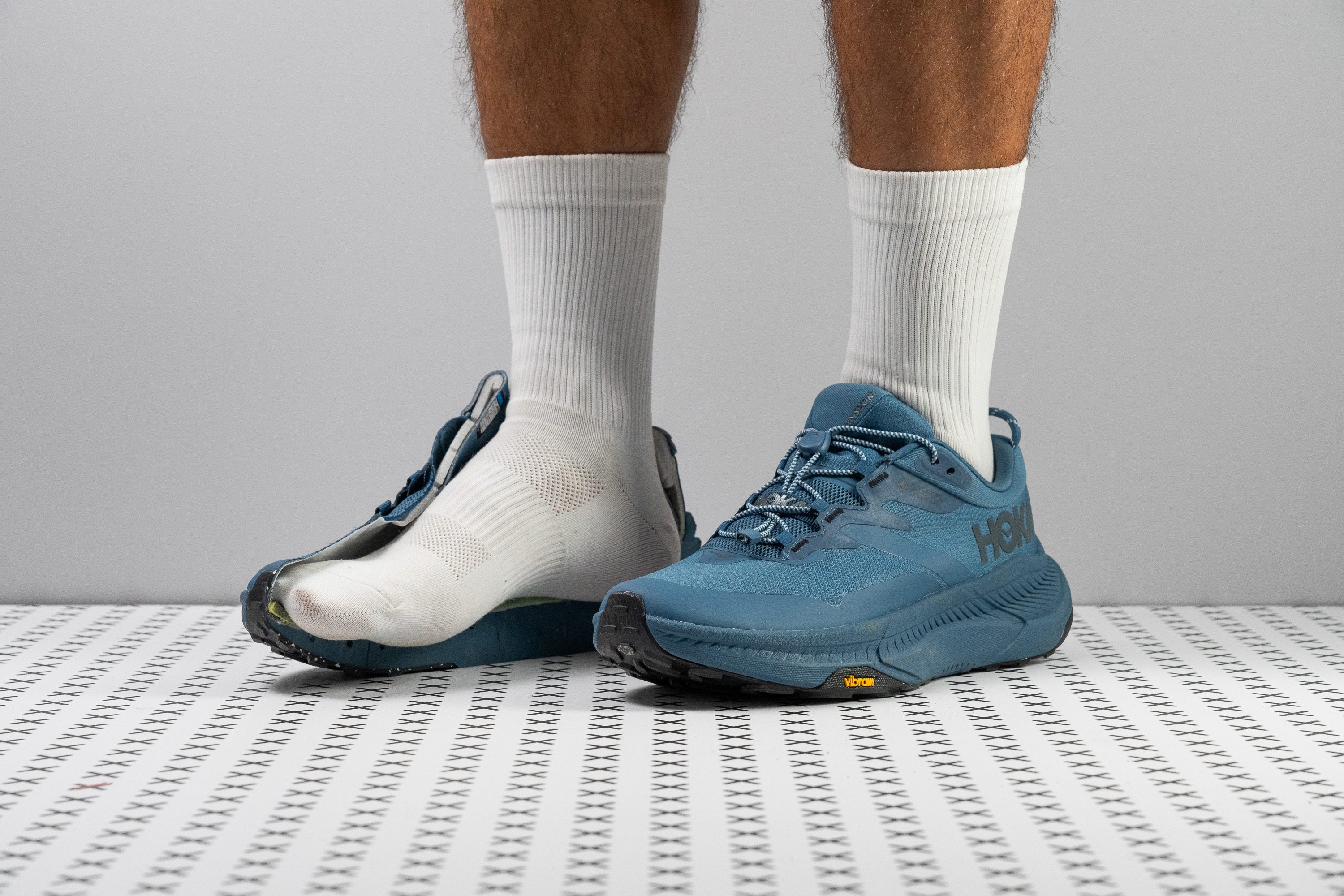






















































What makes it the best?
The Hoka Transport GTX is sealed shut from the outside world, serving as an effective barrier against unwanted elements. Our lab assessments show it has a strong and sturdy construction from top to bottom—with Cordura in the upper and the world-class Vibram rubber in the outsole. Therefore, it’s our top waterproof Hoka walking shoe.
Together with the Gore-Tex membrane, the Cordura material is impermeable and tough, serving as our shield against wet, cold, and abrasive conditions. We stayed warm and dry throughout our encounters with rain, and its low 1/5 breathability rating in our smoke test confirms its watertight nature. The toebox is also highly durable, proven by its 4/5 rating in our Dremel test.
The rugged Transport GTX offers unwavering support through its rigid construction. With its 5/5 torsional rigidity score, it highly resists lateral movement and effectively prevents ankle twists. We remain centred inside the shoe, creating a highly stable ride.
Transport GTX boasts the Vibram outsole’s exceptional grip and strength. In our traction test, it showed a strong 0.56 performance, keeping us confidently steady. We proved its wear resistance when it displayed 28.6% less damage in our Dremel test.
However, all the protection comes at the cost of agility and freedom of movement. Those who prefer more flexibility should go for another walking shoe.
Pros
- Top-class waterproofing
- Cushioned and supportive for all-day wear
- Smooth strides thanks to rockered shape
- Very stable platform
- Highly durable construction
- Excellent grip on dry and wet city streets
- Quick and easy lacing system (regular laces included in the box as well)
- Reflective elements all throughout the upper
- Sustainable materials in almost every shoe part
Cons
- A bit heavier than average
- Major stack and drop discrepancy with official specs
- Not for wide feet
Why choose HOKA shoes for walking?
HOKA was among the first brands that popularised athletic shoes with chunky maximalist midsoles. Over the years, the brand’s name has become synonymous with max-cushioned shoes and earned the company a prominent spot in the footwear market.
So why do people love these puffy designs so much? Thick-foamed midsoles minimise impact forces otherwise absorbed by legs and hips and provide a smooth, supportive, and comfortable ride with little-to-no-fatugue afterwards.
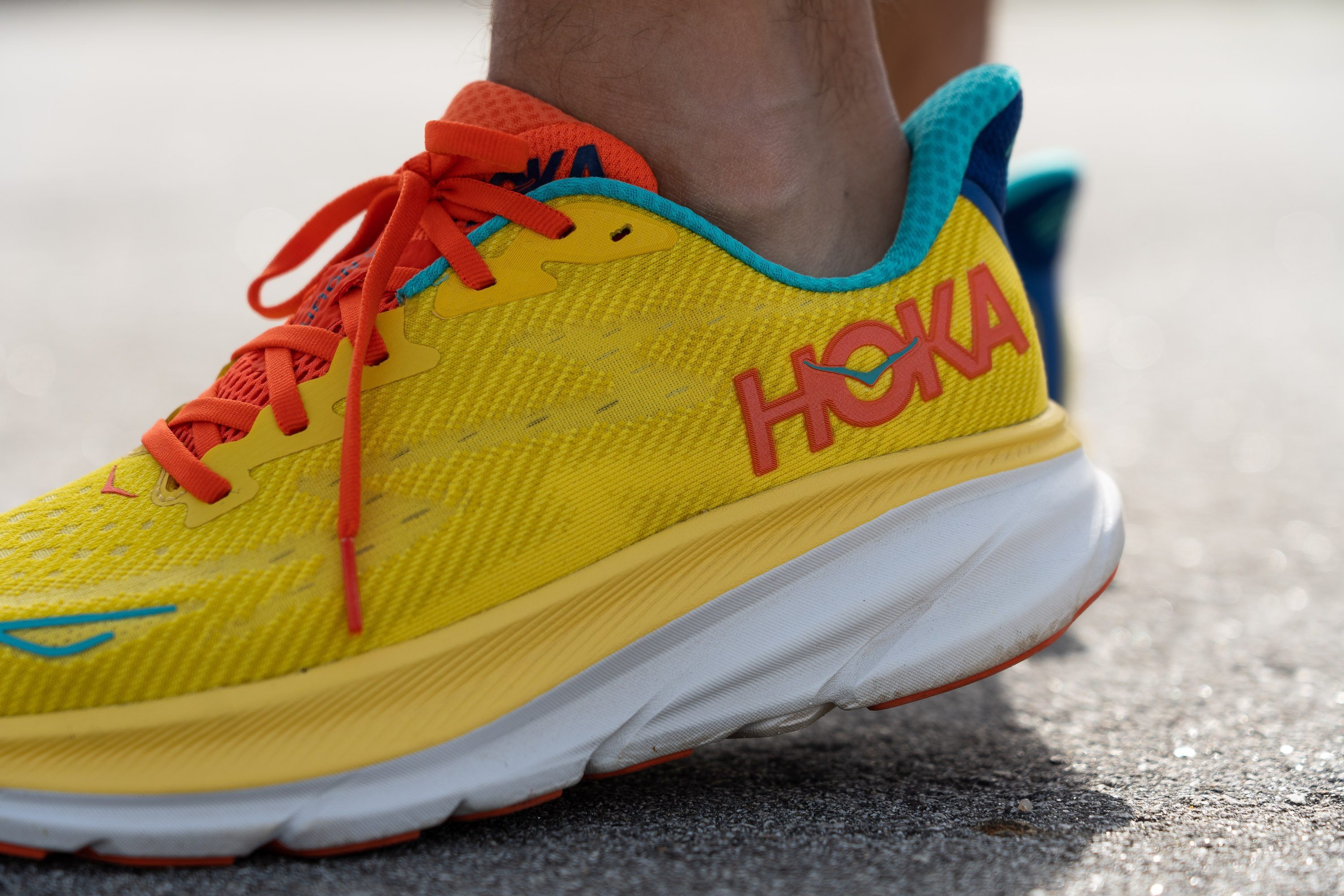
At first, these qualities made HOKA shoes extremely popular for long-distance running, but very soon they also became a top choice for walking and casual wear.
That’s why most of our top picks in this guide include HOKA shoes that were originally designed as running shoes. You can effortlessly switch between walking and running in the following shoes:
Choosing the best HOKA walking shoes for you
At first glance, all HOKA shoes look the same - cushy and comfy. But if you get a chance to try them all in person, you will notice pretty sizable differences in the way they fit and feel on foot.
To help you figure out which HOKA shoe suits your needs the best, we cover the following features in this guide:
- Cushioning: Even though all HOKA shoes are undoubtedly well-cushioned, the amount of shock absorption they provide varies.
- Support: Some HOKA shoes have a more supportive construction, offering pronation control and relief from certain foot conditions.
- Fit: Different lasts and upper materials result in different fit. Some HOKA shoes are more close-fitting, while others are more generous with the toebox space.
- Durability: Are all HOKA shoes equally durable for the price?
- Breathability: From airy and summer-ready to warm and even waterproof HOKAs.
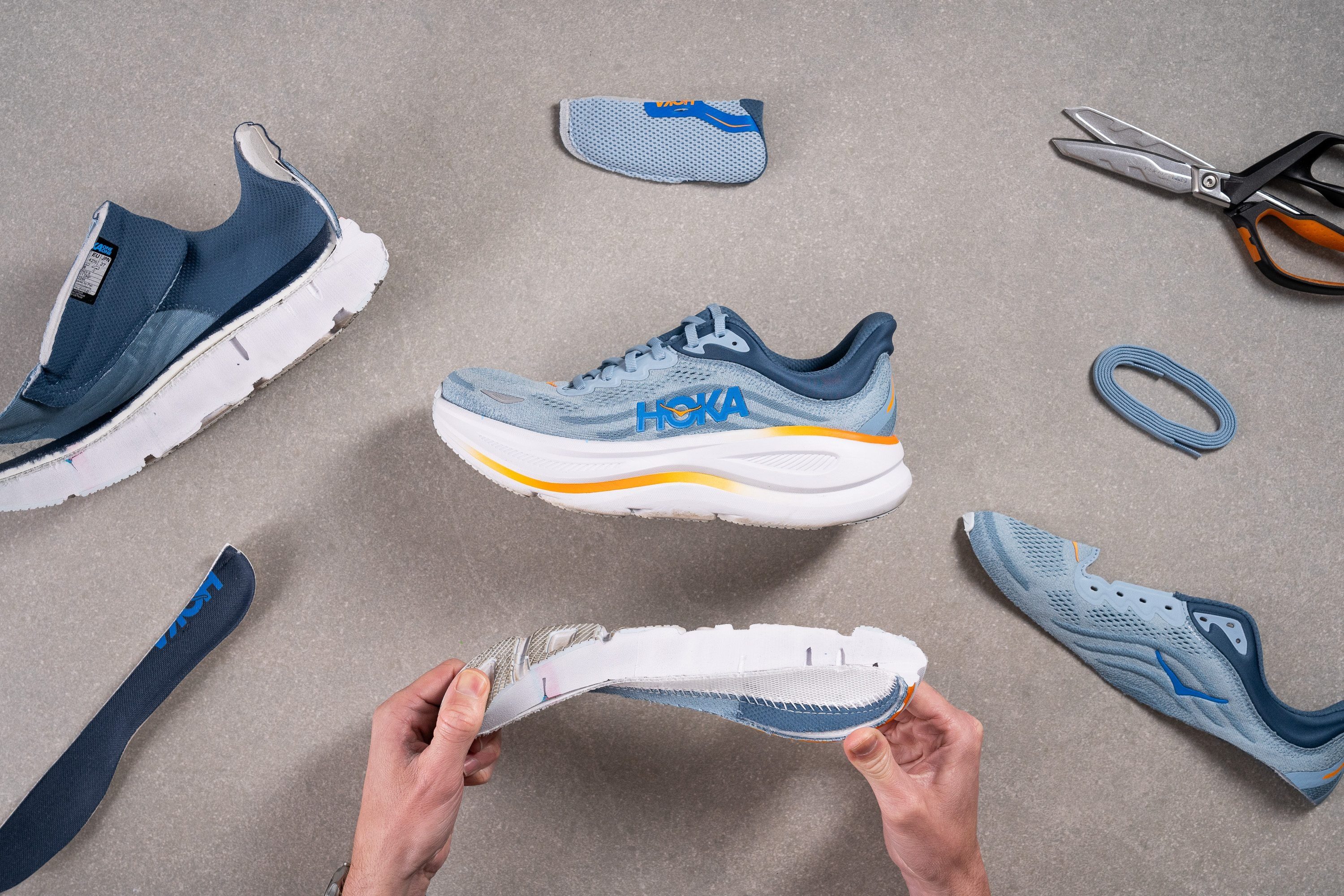
Cushioning in HOKA walking shoes
HOKA shoes are renowned for their exceptional cushioning, so we are not surprised that none of the brand's shoes showed a shock absorption of less than 100 SA in the heel.
This means that whatever pair of HOKA shoes you choose, it will provide enough cushioning and impact protection for long hours of walking and standing.
Our stack measurements also showed that none of the HOKA models have a heel stack of less than 30 mm.
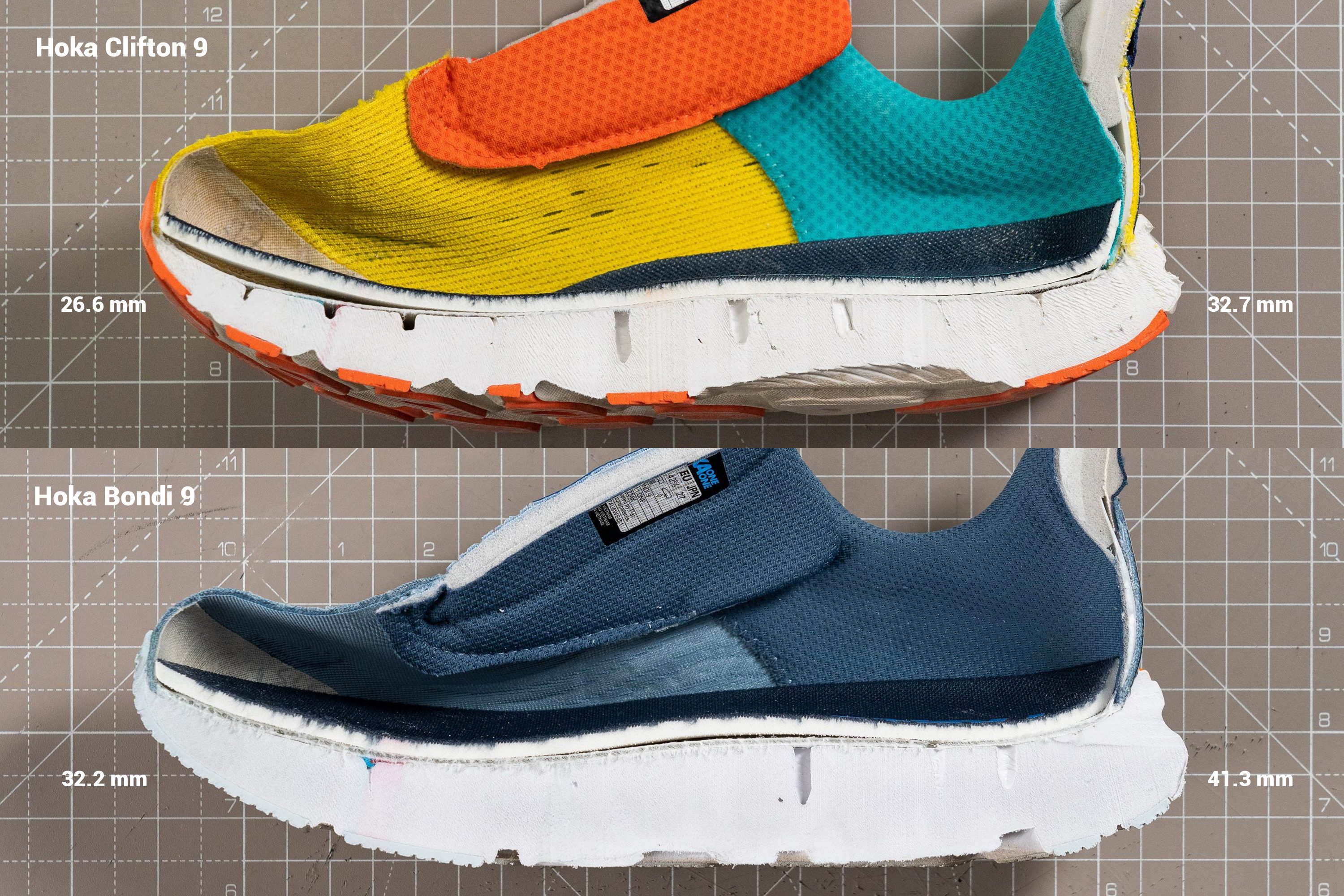
While it’s a matter of personal preference, we think you will benefit from the moderate stack (30-35 mm) if:
- you prefer a more stable and grounded experience
- you want a shoe that can double for moderate gym use (i.e. HOKA Solimar, HOKA Kawana)
On the other hand, you are likely to appreciate the highest stack (35-40 mm) if:
- you need maximum cushioning for walking and standing all day
- you want something cosy for easy recovery walks after sport
Cushioning softness is another important parameter to consider in your future pair of HOKAs.
To help you understand how much plushness to expect, we cut each shoe in half and press a Shore A durometer against its primary and secondary (if any) midsole foam. The lower the HA reading on the tool, the softer the compound:
- plush: 20 HA or less
- balanced: 20-30 HA
- firm: 30 HA or more
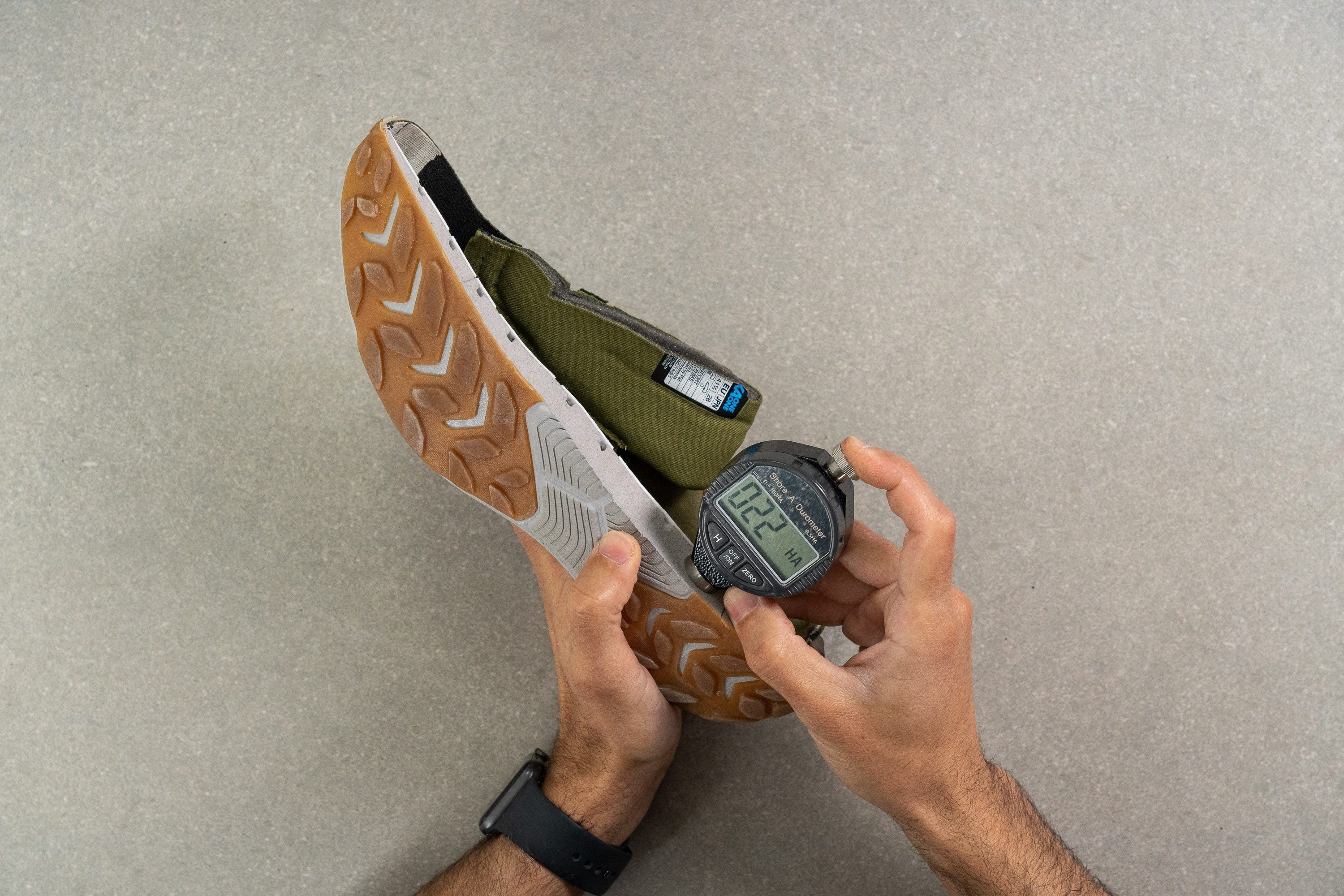
Based on our measurements, there are NO firm HOKA shoes! With an average midsole softness of 22 HA, they are either plush or moderately plush (balanced).
Plush HOKA shoes provide a very enjoyable squishmallow-like underfoot experience. However, you may benefit from a bit firmer ride if:
- you are a heavier person
- you prefer to feel more stable and grounded
- you have conditions that can be aggravated by soft midsoles (i.e. plantar fasciitis)
Supportive HOKA shoes for overpronation and other conditions
Some HOKA shoes are specifically designed to prevent excessive rolling of the foot (aka overpronation) and minimise discomfort associated with this condition.
If you ever experience any of these symptoms, chances are that you need the brand’s stability shoe:
- your heels and ankles collapse inwards when walking or standing
- you shoe soles wear out faster of the inner side
- you experience pain in the feet, ankles, or even lower back after long bouts of walking
You can learn more in our comprehensive guides on walking shoes for overpronation.
Disclaimer: This guide is for educational purposes only. Please consult a doctor for a proper diagnosis.
There are two types of supportive walking shoes from HOKA:
- moderately supportive (J-Frame)
- highly supportive (H-Frame)
The J-Frame is found in the brand’s Arahi series and is meant for mild overpronation.
It features a firmer foam segment in the shape of the letter "J" (grey area in the photo below). It extends along the shoe's inner side (under the foot arch) and wraps around the heel.
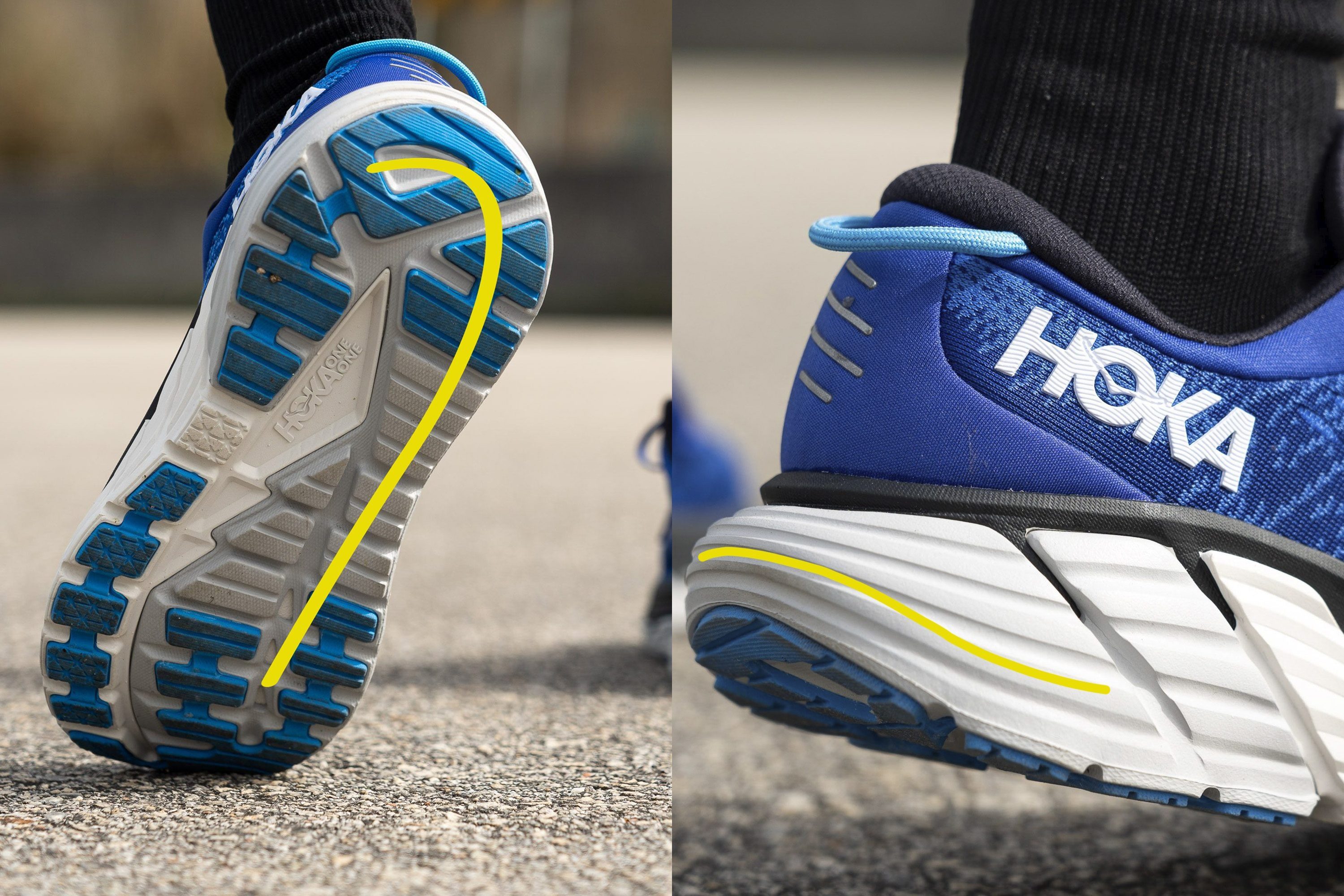
The H-Frame is found in the HOKA Gaviota series which caters to moderate-to-severe overpronation.
Shaped as the letter “H,” it covers the entire midsole perimeter and adds a connecting segment in the midfoot as well. The “H” itself is made of firmer foam while the softer compound can be felt through the cutouts in between. This approach allows to use plush foam without compromising stability.
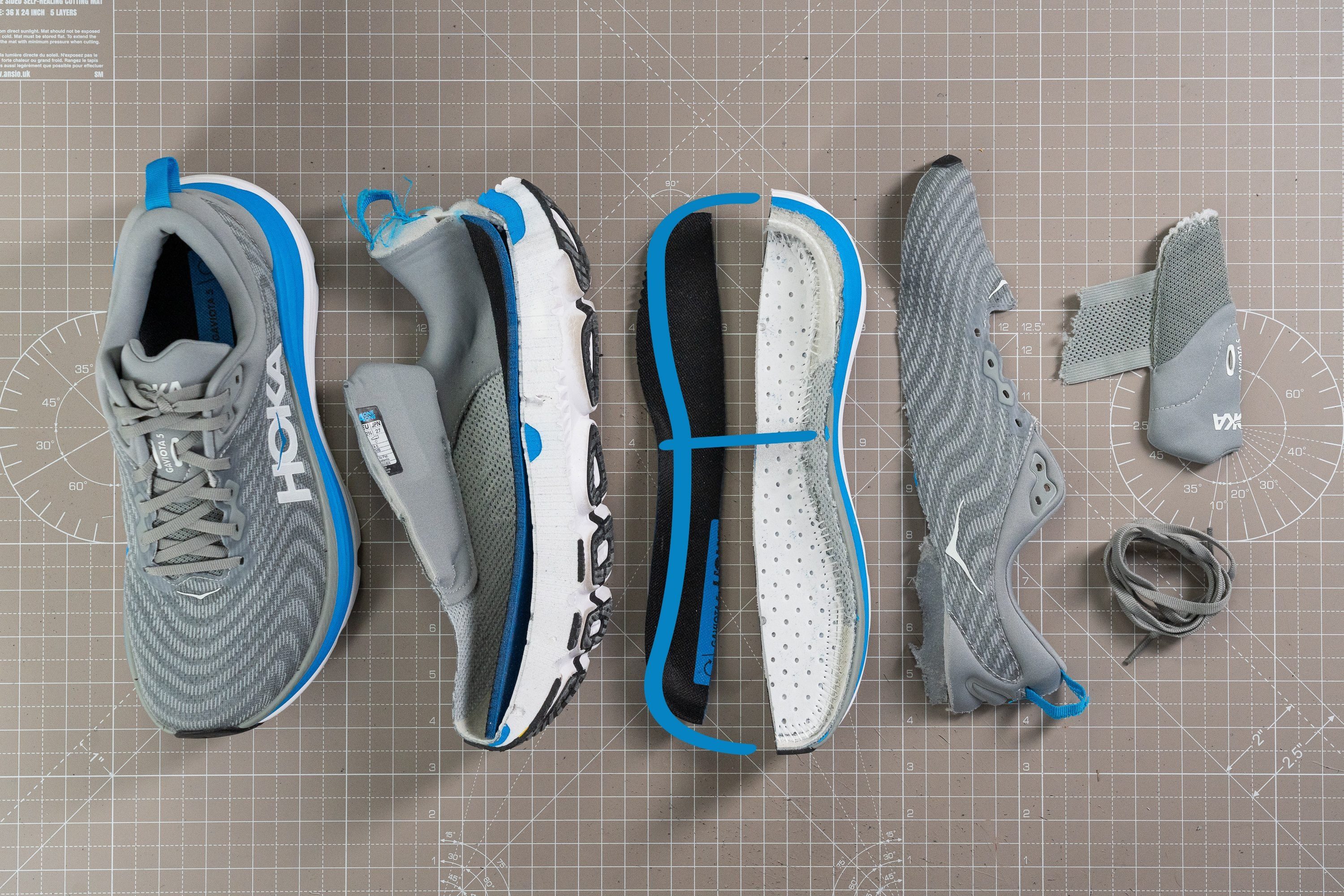
Both frames rely on dual-density foams to provide sufficient torsional rigidity through the midsole. The stiffness makes it nearly impossible to twist the Arahi or the Gaviota which, in turn, prevents the foot from wobbling and buckling.
But that’s not the only feature that’s responsible for support. HOKA stability shoes also come with fairly stiff and well-padded heel counters which lock the rearfoot down in place and minimise undue movement.
Last but not least, they also have nice and wide platforms which provide a large landing area and prevent the foot from spilling over the edge of the sole.
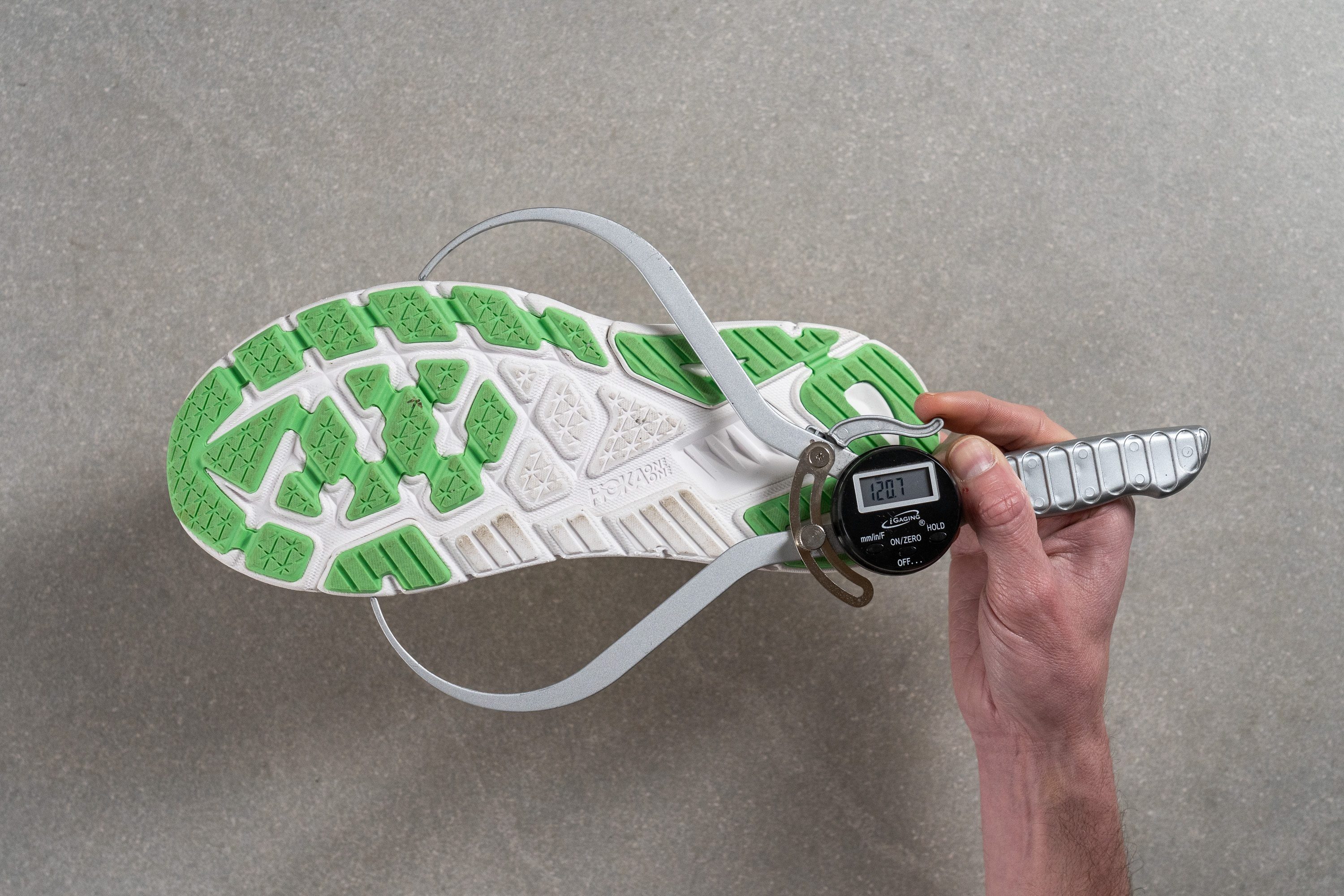
HOKA shoes for plantar fasciitis
The shoe characteristics described above are also applicable to plantar fasciitis.
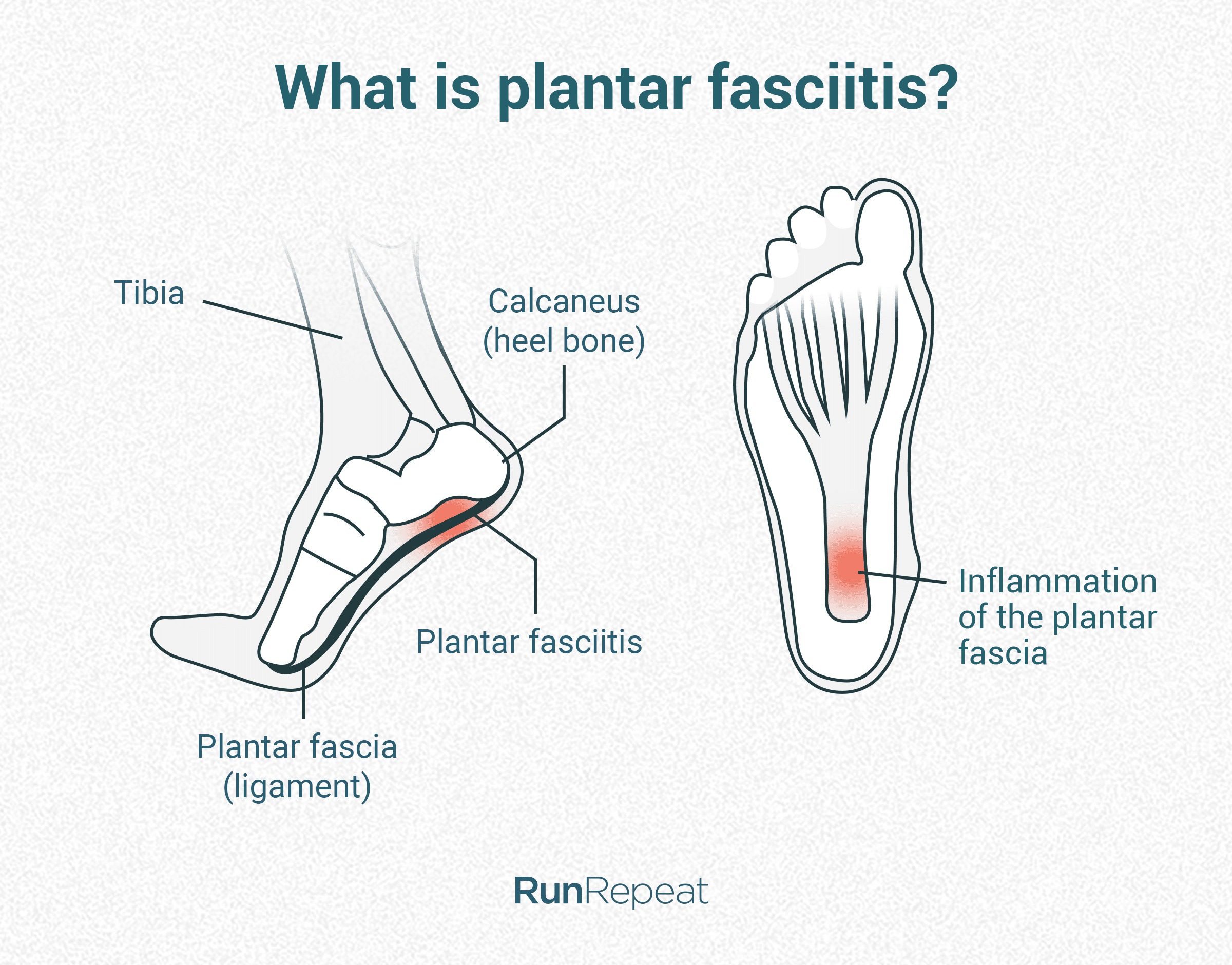
Even though HOKA doesn’t position any of its footwear as recommended for PF, some of its walking shoes meet the science-backed criteria for this painful condition:
|
Features of a plantar fasciitis walking shoe |
|
|
Wide and stable sole |
Provides the needed stability and sure-footedness. |
|
Good shock absorption and moderately soft cushioning |
Decreases the impact forces while walking. The heel area should have additional cushioning to take the strain off the plantar fascia ligament. |
|
Stiff and supportive heel counter |
Keeping the heel steady minimises additional stretching of the plantar fascia. |
Having tested each HOKA shoe, we found that the following models meet the aforementioned criteria:
Getting the right size and fit in HOKA walking shoes
HOKA walking shoes are generally consistent with the brand’s size chart and tend to fit true to size. But having tested dozens of HOKA shoes, we couldn’t help but notice the differences in their forefoot shapes, toebox space, and overall fit.
Size: To make your online shopping as hassle-free as possible and avoid returns, we highly recommend measuring your current foot length first. This will increase your chances of ordering the right size length-wise.
- Follow these 3 simple steps to get the measurements. Ask a friend to help you for more accurate results.
- Find out which HOKA shoe size suits you best in the brand’s size chart.
- Check out the Size section in our corresponding HOKA shoe review to see if any size adjustments are recommended for that specific model.
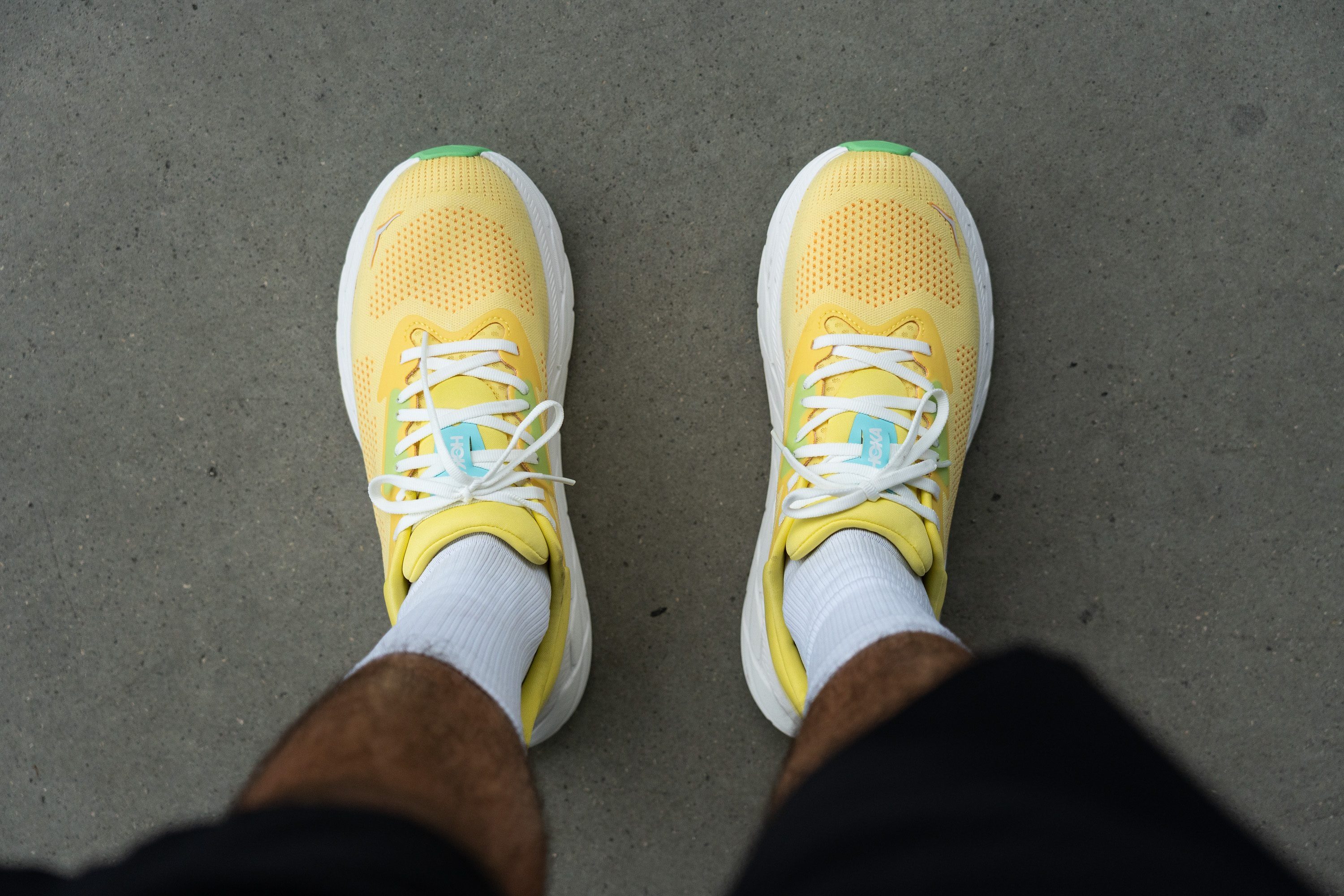
Fit: The internal shape and dimensions of HOKA shoes can vary quite a bit, even in the same size!
That’s why we developed a mould-pouring process using a custom gel formula. The gels takes up the inner space of the shoe and freezes solid allowing us to measure its dimensions with a digital calliper.
The photo below shows the 1:1 gel replicas of two different HOKA shoe interiors in the same size (men’s US 9). Measuring the width of both moulds in their widest parts (between the pinkie and the big toe), we got 91.1 mm in one shoe and 99.7 mm in the other. Nearly a centimetre of difference!
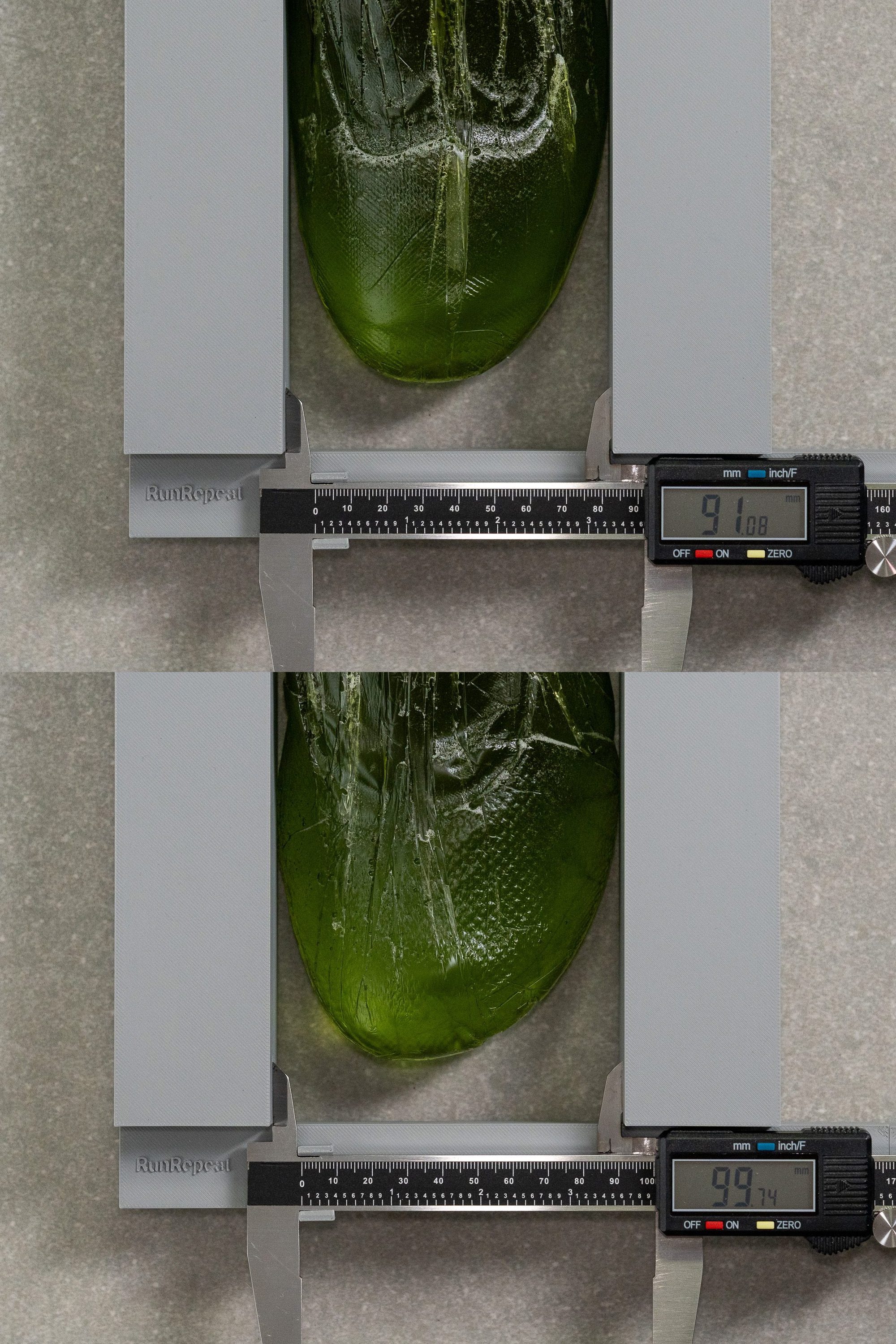
We also measure the width of each mould near the big toe to assess the amount of toebox tapering. The narrower the reading, the pointier the toebox, and vice versa. If you prefer more rounded toebox shapes that comfortably accommodate all five toes, get a HOKA shoe with more room near the big toe.
Durability of walking shoes from HOKA
Walking shoes from HOKA are definitely not the cheapest. So you want to make sure that you’re getting the best value for money and don’t have to run for a replacement pair on a couple of months.
In our lab, we take each HOKA shoe through the wringer by means of sandpaper and a Dremel. We apply the tool to the following shoe parts:
- upper fabric on top of the toebox
- fabric lining inside the heel collar
- rubber outsole at the bottom
Testing conditions remain the same for each shoe part for consistency.
Once the drilling is done, we assess the abrasion resistance of each part on a 1-5 scale where 5 stands for most durable. For the outsole, however, we show the exact depth of the dent (the smaller, the better).
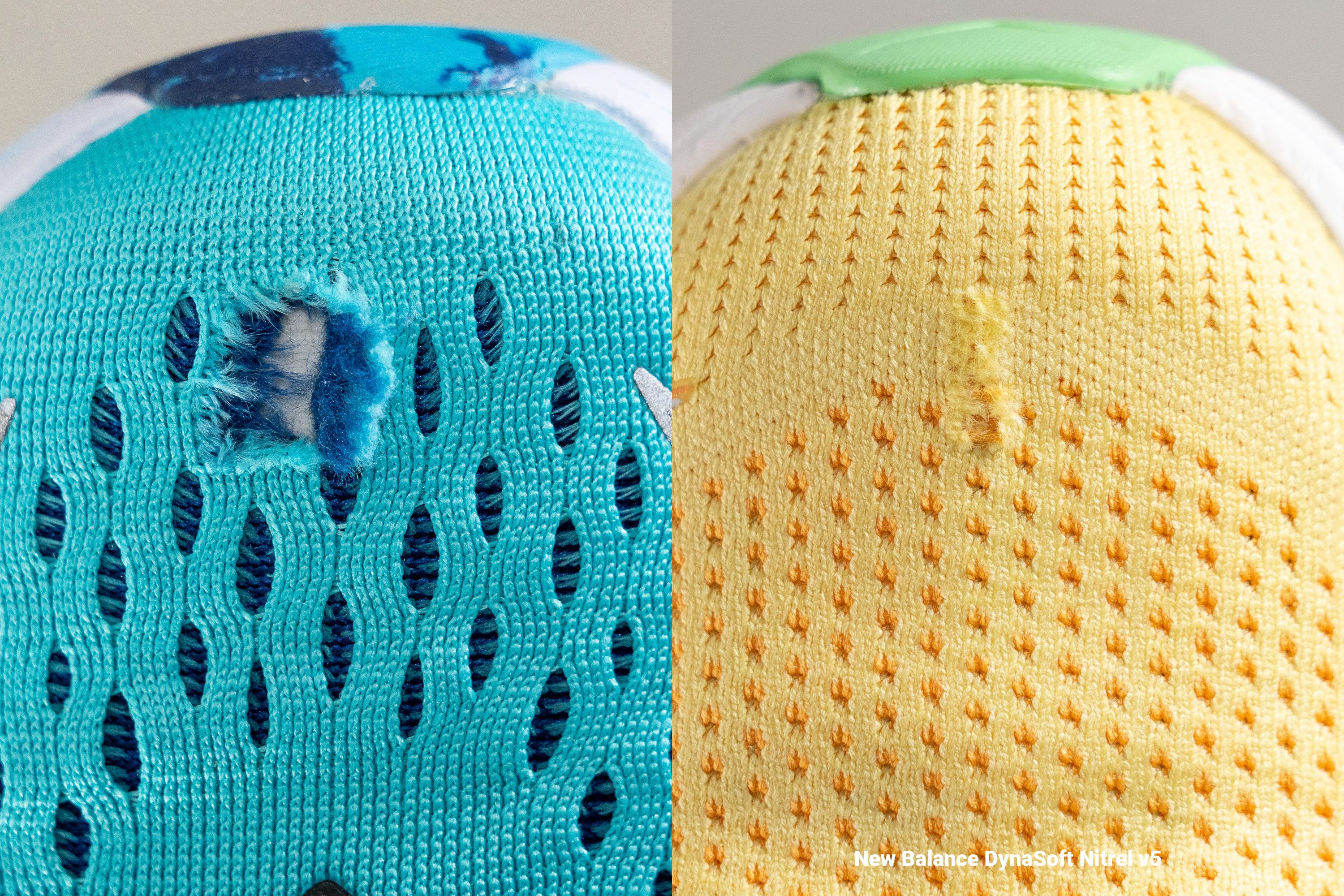
Here is the overview of HOKA walking shoes with the most durable components in both the upper and the outsole:
Even though we don’t have a durability test for it (yet), it is equally important to consider the shoe’s cushioning longevity. However, it is trickier to test because foam deterioration is not as evident as holes in the upper or missing rubber on the outsole.
Most athletic shoes have a life expectancy of about 300-500 miles (480-800 km). So once you have worn a HOKA shoe past that point, watch out for the following signs of cushioning degradation:
- the midsole got notably thinner and flatter
- the sole is tilted to one side (mirroring your overpronation)
- you start to experience discomfort or pain in your feet and legs
- your legs and feet feel more tired after the walk
HOKA walking shoes for every season
A vast majority of HOKA walking shoes use some sort of mesh for their uppers. And even though it is a pretty breathable type of fabric, not all HOKA shoes are equally breathable.
We perform a series of breathability tests in our lab to check how much airflow you can expect in a given shoe. These tests include:
- pumping smoke through the shoe’s toebox to check its permeability
- hovering the half-cut upper over the light to check its pores and ventilation channels
- examining the structure of a given mesh fabric through a microscope
Once all the testing procedures are done, we rate each shoe’s breathability on a 1-5 scale where 5 goes out to shoes with the best ventilation capacity.
On the other hand, you might as well appreciate a less breathable HOKA shoe for the cooler months of spring and fall. In this case, shoes with a moderate breathability of 2, 3, and 4 would be a better choice.
And if you are looking for a winter-ready waterproof walking shoe, some of HOKA’s popular silhouettes are also available in a GTX version. GORE-TEX is a world-class waterproofing membrane which keeps the foot dry and warm.

